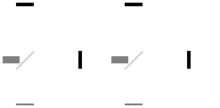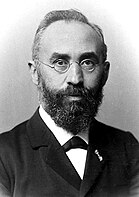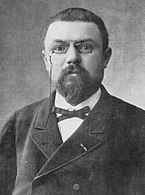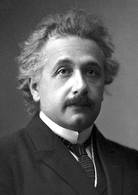User:Halibutt/Spacetime/History
History[edit]
Click here for a brief section summary
By the mid-1800s, various experiments such as the observation of the Arago spot (a bright point at the center of a circular object's shadow due to diffraction) and differential measurements of the speed of light in air versus water were considered to have proven the wave nature of light as opposed to a corpuscular theory.[1] Propagation of waves was then (wrongly) assumed to require the existence of a medium which waved: in the case of light waves, this was considered to be a hypothetical luminiferous aether.[note 1] However, the various attempts to establish the properties of this hypothetical medium yielded contradictory results. For example, the Fizeau experiment of 1851 demonstrated that the speed of light in flowing water was less than the sum of the speed of light in air plus the speed of the water by an amount dependent on the water's index of refraction. Among other issues, the dependence of the partial aether-dragging implied by this experiment on the index of refraction (which is dependent on wavelength) led to the unpalatable conclusion that aether simultaneously flows at different speeds for different colors of light.[2] The famous Michelson–Morley experiment of 1887 (Fig. 1‑2) showed no differential influence of Earth's motions through the hypothetical aether on the speed of light, and the most likely explanation, complete aether dragging, was in conflict with the observation of stellar aberration.[3]
George Francis FitzGerald in 1889 and Hendrik Lorentz in 1892 independently proposed that material bodies traveling through the fixed aether were physically affected by their passage, contracting in the direction of motion by an amount that was exactly what was necessary to explain the negative results of the Michelson-Morley experiment. (No length changes occur in directions transverse to the direction of motion.)
By 1904, Lorentz had expanded his theory such that he had arrived at equations formally identical with those that Einstein were to derive later (i.e. the Lorentz transform), but with a fundamentally different interpretation. As a theory of dynamics (the study of forces and torques and their effect on motion), his theory assumed actual physical deformations of the physical constituents of matter.[4]: 163–174 Lorentz's equations predicted a quantity that he called local time, with which he could explain the aberration of light, the Fizeau experiment and other phenomena. However, Lorentz considered local time to be only an auxiliary mathematical tool, a trick as it were, to simplify the transformation from one system into another.
Other physicists and mathematicians at the turn of the century came close to arriving at what is currently known as spacetime. Einstein himself noted, that with so many people unraveling separate pieces of the puzzle, "the special theory of relativity, if we regard its development in retrospect, was ripe for discovery in 1905."[5]
An important example is Henri Poincaré,[6][7]: 73–80, 93–95 who in 1898 argued that the simultaneity of two events is a matter of convention.[8][note 2] In 1900, he recognized that Lorentz's "local time" is actually what is indicated by moving clocks by applying an explicitly operational definition of clock synchronization assuming constant light speed.[note 3] In 1900 and 1904, he suggested the inherent undetectability of the aether by emphasizing the validity of what he called the principle of relativity, and in 1905/1906[9] he mathematically perfected Lorentz's theory of electrons in order to bring it into accordance with the postulate of relativity. While discussing various hypotheses on Lorentz invariant gravitation, he introduced the innovative concept of a 4-dimensional space-time by defining various four vectors, namely four-position, four-velocity, and four-force.[10][11] He did not pursue the 4-dimensional formalism in subsequent papers, however, stating that this line of research seemed to "entail great pain for limited profit", ultimately concluding "that three-dimensional language seems the best suited to the description of our world".[11] Furthermore, even as late as 1909, Poincaré continued to believe in the dynamical interpretation of the Lorentz transform.[4]: 163–174 For these and other reasons, most historians of science argue that Poincaré did not invent what is now called special relativity.[7][4]
In 1905, Einstein introduced special relativity (even though without using the techniques of the spacetime formalism) in its modern understanding as a theory of space and time.[7][4] While his results are mathematically equivalent to those of Lorentz and Poincaré, it was Einstein who showed that the Lorentz transformations are not the result of interactions between matter and aether, but rather concern the nature of space and time itself. Einstein performed his analyses in terms of kinematics (the study of moving bodies without reference to forces) rather than dynamics. He obtained all of his results by recognizing that the entire theory can be built upon two postulates: The principle of relativity and the principle of the constancy of light speed. In addition, Einstein in 1905 superseded previous attempts of an electromagnetic mass-energy relation by introducing the general equivalence of mass and energy, which was instrumental for his subsequent formulation of the equivalence principle in 1907, which declares the equivalence of inertial and gravitational mass. By using the mass-energy equivalence, Einstein showed, in addition, that the gravitational mass of a body is proportional to its energy content, which was one of early results in developing general relativity. While it would appear that he did not at first think geometrically about spacetime,[12]: 219 in the further development of general relativity Einstein fully incorporated the spacetime formalism.
When Einstein published in 1905, another of his competitors, his former mathematics professor Hermann Minkowski, had also arrived at most of the basic elements of special relativity. Max Born recounted a meeting he had made with Minkowski, seeking to be Minkowski's student/collaborator:[13]
| “ | I went to Cologne, met Minkowski and heard his celebrated lecture 'Space and Time' delivered on 2 September 1908. […] He told me later that it came to him as a great shock when Einstein published his paper in which the equivalence of the different local times of observers moving relative to each other was pronounced; for he had reached the same conclusions independently but did not publish them because he wished first to work out the mathematical structure in all its splendor. He never made a priority claim and always gave Einstein his full share in the great discovery. | ” |
Minkowski had been concerned with the state of electrodynamics after Michelson's disruptive experiments at least since the summer of 1905, when Minkowski and David Hilbert led an advanced seminar attended by notable physicists of the time to study the papers of Lorentz, Poincaré et al. However, it is not at all clear when Minkowski began to formulate the geometric formulation of special relativity that was to bear his name, or to which extent he was influenced by Poincaré's four-dimensional interpretation of the Lorentz transformation. Nor is it clear if he ever fully appreciated Einstein's critical contribution to the understanding of the Lorentz transformations, thinking of Einstein's work as being an extension of Lorentz's work.[14]
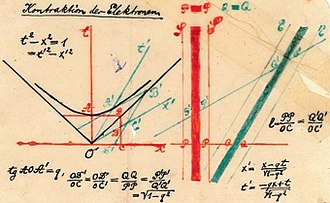
A little more than a year before his death, Minkowski introduced his geometric interpretation of spacetime to the public on November 5, 1907 in a lecture to the Göttingen Mathematical society with the title, The Relativity Principle (Das Relativitätsprinzip). In the original version of this lecture, Minkowski continued to use such obsolescent terms as the ether, but the posthumous publication in 1915 of this lecture in the Annals of Physics (Annalen der Physik) was edited by Sommerfeld to remove this term. Sommerfeld also edited the published form of this lecture to revise Minkowski's judgement of Einstein from being a mere clarifier of the principle of relativity, to being its chief expositor.[13] On December 21, 1907, Minkowski spoke again to the Göttingen scientific society, and on September 21, 1908, Minkowski presented his famous talk, Space and Time (Raum und Zeit),[15] to the German Society of Scientists and Physicians.[note 4]
The opening words of Space and Time include Minkowski's famous statement that "Henceforth, space for itself, and time for itself shall completely reduce to a mere shadow, and only some sort of union of the two shall preserve independence." Space and Time included the first public presentation of spacetime diagrams (Fig. 1‑4), and included a remarkable demonstration that the concept of the invariant interval (discussed below), along with the empirical observation that the speed of light is finite, allows derivation of the entirety of special relativity.[note 5]
Einstein, for his part, was initially dismissive of Minkowski's geometric interpretation of special relativity, regarding it as überflüssige Gelehrsamkeit (superfluous learnedness). However, in order to complete his search for general relativity that started in 1907, the geometric interpretation of relativity proved to be vital, and in 1916, Einstein fully acknowledged his indebtedness to Minkowski, whose interpretation greatly facilitated the transition to general relativity.[4]: 151–152 Since there are other types of spacetime, such as the curved spacetime of general relativity, the spacetime of special relativity is today known as Minkowski spacetime.
- ^ Hughes, Stefan (2013). Catchers of the Light: Catching Space: Origins, Lunar, Solar, Solar System and Deep Space. Paphos, Cyprus: ArtDeCiel Publishing. pp. 202–233. ISBN 9781467579926. Retrieved 7 April 2017.
- ^ Stachel, John (2005). "Fresnel's (Dragging) Coefficient as a Challenge to 19th Century Optics of Moving Bodies.". In Kox, A. J.; Eisenstaedt, Jean (eds.). The Universe of General Relativity. Boston: Birkhäuser. pp. 1–13. ISBN 081764380X. Archived from the original (PDF) on 2017-04-13.
- ^ Cite error: The named reference
Frenchwas invoked but never defined (see the help page). - ^ a b c d e Pais, Abraham (1982). ""Subtle is the Lord-- ": The Science and the Life of Albert Einstein (11th ed.). Oxford: Oxford University Press. ISBN 019853907X.
- ^ Born, Max (1956). Physics in My Generation. London & New York: Pergamon Press. p. 194. Retrieved 10 July 2017.
- ^ Darrigol, O. (2005), "The Genesis of the theory of relativity" (PDF), Séminaire Poincaré, 1: 1–22, Bibcode:2006eins.book....1D, doi:10.1007/3-7643-7436-5_1, ISBN 978-3-7643-7435-8
- ^ a b c Miller, Arthur I. (1998). Albert Einstein's Special Theory of Relativity. New York: Springer-Verlag. ISBN 0387948708.
- ^ Galison, Peter (2003). Einstein's Clocks, Poincaré's Maps: Empires of Time. New York: W. W. Norton & Company, Inc. pp. 13–47. ISBN 0393020010.
- ^ Poincare, Henri (1906). "On the Dynamics of the Electron (Sur la dynamique de l'électron)". Rendiconti del Circolo matematico di Palermo. 21: 129–176. Retrieved 15 July 2017.
- ^ Zahar, Elie (1989) [1983], "Poincaré's Independent Discovery of the relativity principle", Einstein's Revolution: A Study in Heuristic, Chicago: Open Court Publishing Company, ISBN 0-8126-9067-2
- ^ a b Walter, Scott A. (2007). "Breaking in the 4-vectors: the four-dimensional movement in gravitation, 1905–1910". In Renn, Jürgen; Schemmel, Matthias (eds.). The Genesis of General Relativity, Volume 3. Berlin: Springer. pp. 193–252. Archived from the original on July 14, 2017. Retrieved 15 July 2017.
- ^ Schutz, Bernard (2004). Gravity from the Ground Up: An Introductory Guide to Gravity and General Relativity (Reprint ed.). Cambridge: Cambridge University Press. ISBN 0521455065. Retrieved 24 May 2017.
- ^ a b Weinstein, Galina. "Max Born, Albert Einstein and Hermann Minkowski's Space-Time Formalism of Special Relativity". arXiv. Cornell University Library. Retrieved 11 July 2017.
- ^ Galison, Peter Louis (1979). "Minkowski's space-time: From visual thinking to the absolute world". Historical Studies in the Physical Sciences. 10: 85–121. doi:10.2307/27757388. JSTOR 27757388.
- ^ Minkowski, Hermann (1909). "Raum und Zeit" [Space and Time]. Jahresberichte der Deutschen Mathematiker-Vereinigung. B.G. Teubner: 1–14.
Cite error: There are <ref group=note> tags on this page, but the references will not show without a {{reflist|group=note}} template (see the help page).


